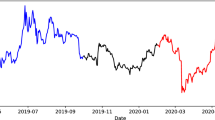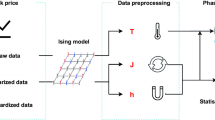Abstract
Although many methods for computing the Greeks of discrete-time Asian options are proposed, few methods to calculate the Greeks of continuous-time Asian options are known. In this paper, we develop an integration by parts formula in the multi-dimensional Malliavin calculus, and apply it to obtain the Greeks formulae for continuous-time Asian options in the multi-asset situation. We combine the Malliavin method with the quasi-Monte Carlo method to calculate the Greeks in simulation. We discuss the asymptotic convergence of simulation estimates for the continuous-time Asian option Greeks obtained by Malliavin derivatives. We propose to use the conditional quasi-Monte Carlo method to smooth Malliavin Greeks, and show that the calculation of conditional expectations analytically is viable for many types of Asian options. We prove that the new estimates for Greeks have good smoothness. For binary Asian options, Asian call options and up-and-out Asian call options, for instance, our estimates are infinitely times differentiable. We take the gradient principal component analysis method as a dimension reduction technique in simulation. Numerical experiments demonstrate the large efficiency improvement of the proposed method, especially for Asian options with discontinuous payoff functions.
Similar content being viewed by others
Notes
In fact, this space is an irreducible Gaussian space \((\varOmega ,{{\mathscr {F}}},{\mathbb {P}};H)\). Here, \((\varOmega ,{{\mathscr {F}}},{\mathbb {P}})\) is a complete probability space, H is a real separable Hilbert space, \(\{U_h\}_{h\in H}\) is a family of Gaussian random variables satisfying \({\mathbb {E}}[U_h]=0\) and \({\mathbb {E}}[U_hU_g]=(h,g)_H\) (the inner product of h and g in H) for all \(h,g\in H\), and \({{\mathscr {F}}}\) is the completion of the \(\sigma \)-algebra generated by \(\{U_h\}_{h\in H}\) with respect to \({\mathbb {P}}\). We refer to Huang and Yan (2000) for more details.
References
Bayer, C., Siebenmorgen, M., & Tempone, R. (2018). Smoothing the payoff for efficient computation of basket option prices. Quantitative Finance, 18, 491–505.
Benhamou, E. (2000). An application of Malliavin calculus to continuous time Asian Option Greeks. London School of Economics: Technical report.
Brezis, H. (2010). Functional analysis Sobolev spaces and partial differential equations. Springer.
Broadie, M., & Glasserman, P. (1996). Estimating security price derivatives using simulation. Management Science, 42, 269–285.
Caflisch, R. E., Morokoff, W. J., & Owen, A. B. (1997). Valuation of mortgage-backed securities using Brownian bridges to reduce effective dimension. Journal of Computational Finance, 1, 27–46.
Di Nunno, G., Øksendal, B., & Proske, F. (2009). Malliavin calculus for Lévy processes with applications to finance. Springer.
Faure, H. (1982). Discrépance de suites associées à un système de numération (en dimension s). Acta Arithmetica, 41, 337–351.
Fournié, E., Lasry, J., Lebuchoux, J., Lions, P. L., & Touzi, N. (1999). Applications of Malliavin calculus to Monte Carlo method in finance I. Finance and Stochastics, 3, 391–412.
Fu, M. C., & Hu, J. Q. (1997). Conditional Monte Carlo: Gradient estimation and optimization applications. Kluwer Academic.
Glasserman, P. (2004). Monte Carlo methods in financial engineering. Springer.
Glynn, P.W. (1987). Likelihood ratio gradient estimation: An overview, In Proceedings of the 19th Conference on Winter Simulation, IEEE Press, pp. 366–375.
Halton, J. H. (1960). On the efficiency of certain quasi-random sequences of points in evaluating multi-dimensional integrals. Numerische Mathematik, 2, 84–90.
He, Z., & Wang, X. (2014). Good path generation methods in quasi-Monte Carlo for pricing financial derivatives. SIAM Journal on Scientific Computing, 36, B171–B197.
Ho, Y. C., & Cao, X. (1983). Perturbation analysis and optimization of queueing networks. Journal of Optimization Theory and Applications, 40, 559–582.
Huang, Z., & Yan, J. (2000). Introduction to infinite dimensional stochastic analysis. Springer.
Hull, J. C. (2022). Options, futures, and other derivatives (11th ed.). Pearson.
Imai, J., & Tan, K. S. (2004). Minimizing effective dimension using linear transformation. Monte Carlo and Quasi-Monte Carlo Methods 2002 (pp. 275–292). Springer.
Karatzas, I., & Shreve, S. (1991). Brownian motion and stochastic calculus. Springer.
L’Ecuyer, P., & Lemieux, C. (2005). Recent advances in randomized quasi-Monte Carlo methods, In Proceedings of the Modeling Uncertainty: An Examination of Stochastic Theory, Methods, and Applications, Springer, pp. 419-474.
Matoušek, J. (1998). On the \(L_2\)-discrepancy for anchored boxes. Journal of Complexity, 14, 527–556.
Morokoff, W. J., & Caflisch, R. E. (1995). Quasi-Monte Carlo integration. Journal of Computational Physics, 122, 218–230.
Niederreiter, H. (1992). Random number generation and Quasi-Monte Carlo methods. SIAM.
Nualart, D. (2006). The Malliavin calculus and related topics (2nd ed.). Springer.
Ocone, D. L., & Karatzas, I. (1991). A generalized Clark representation formula with application to optimal portfolios. Stochastics, 34, 187–220.
Owen, A. B. (1998). Scrambling Sobol’ and Niederreiter-Xing points. Journal of Complexity, 14, 466–489.
Sobol, I. M. (1967). On the distribution of points in a cube and the approximate evaluation of integrals. USSR Computational Mathematics and Mathematical Physics, 7, 86–112.
Wang, X., & Fang, K. T. (2003). The effective dimension and quasi-Monte Carlo integration. Journal of Complexity, 19, 101–124.
Wang, X., & Tan, K. S. (2013). Pricing and hedging with discontinuous functions: Quasi-Monte Carlo methods and dimension reduction. Management Science, 59, 376–389.
Weng, C., Wang, X., & He, Z. (2017). Efficient computation of option prices and Greeks by quasi-Monte Carlo method with smoothing and dimension reduction. SIAM Journal on Scientific Computing, 39, B298–B322.
Xiao, Y., & Wang, X. (2018). Conditional quasi-Monte Carlo methods and dimension reduction for option pricing and hedging with discontinuous functions. Journal of Computational and Applied Mathematics, 343, 289–308.
Xiao, Y., & Wang, X. (2019). Enhancing quasi-Monte Carlo simulation by minimizing effective dimension for derivative pricing. Computational Economics, 54, 343–366.
Xu, Y., Lai, Y., & Yao, H. (2014). Efficient simulation of Greeks of multiasset European and Asian style options by Malliavin calculus and quasi-Monte Carlo methods. Applied Mathematics and Computation, 236, 493–511.
Zhang, C., & Wang, X. (2020). Quasi-Monte Carlo-based conditional pathwise method for option Greeks. Quantitative Finance, 20, 49–67.
Acknowledgements
The authors are very grateful to the editors and the anonymous referee for their helpful suggestions and comments.
Funding
The work is funded by the National Natural Science Foundation of China (No. 72071119).
Author information
Authors and Affiliations
Corresponding author
Ethics declarations
Conflict of interest
The authors declare that they have no conflict of interest. All authors certify that they have no affiliations with or involvement in any organization or entity with any financial interest or non-financial interest in the subject matter or materials discussed in this manuscript.
Additional information
Publisher's Note
Springer Nature remains neutral with regard to jurisdictional claims in published maps and institutional affiliations.
Rights and permissions
About this article
Cite this article
Yu, C., Wang, X. Quasi-Monte Carlo-Based Conditional Malliavin Method for Continuous-Time Asian Option Greeks. Comput Econ 62, 325–360 (2023). https://doi.org/10.1007/s10614-022-10257-3
Accepted:
Published:
Issue Date:
DOI: https://doi.org/10.1007/s10614-022-10257-3




